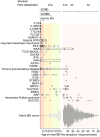The diagnostic approach to monogenic very early onset inflammatory bowel disease
- PMID: 25058236
- PMCID: PMC5376484
- DOI: 10.1053/j.gastro.2014.07.023
The diagnostic approach to monogenic very early onset inflammatory bowel disease
Abstract
Patients with a diverse spectrum of rare genetic disorders can present with inflammatory bowel disease (monogenic IBD). Patients with these disorders often develop symptoms during infancy or early childhood, along with endoscopic or histological features of Crohn's disease, ulcerative colitis, or IBD unclassified. Defects in interleukin-10 signaling have a Mendelian inheritance pattern with complete penetrance of intestinal inflammation. Several genetic defects that disturb intestinal epithelial barrier function or affect innate and adaptive immune function have incomplete penetrance of the IBD-like phenotype. Several of these monogenic conditions do not respond to conventional therapy and are associated with high morbidity and mortality. Due to the broad spectrum of these extremely rare diseases, a correct diagnosis is frequently a challenge and often delayed. In many cases, these diseases cannot be categorized based on standard histological and immunologic features of IBD. Genetic analysis is required to identify the cause of the disorder and offer the patient appropriate treatment options, which include medical therapy, surgery, or allogeneic hematopoietic stem cell transplantation. In addition, diagnosis based on genetic analysis can lead to genetic counseling for family members of patients. We describe key intestinal, extraintestinal, and laboratory features of 50 genetic variants associated with IBD-like intestinal inflammation. In addition, we provide approaches for identifying patients likely to have these disorders. We also discuss classic approaches to identify these variants in patients, starting with phenotypic and functional assessments that lead to analysis of candidate genes. As a complementary approach, we discuss parallel genetic screening using next-generation sequencing followed by functional confirmation of genetic defects.
Keywords: Crohn’s Disease; Genetics; IBD Unclassified; Immunodeficiency; Indeterminate Colitis; Inflammatory Bowel Disease; Next-Generation Sequencing; Pediatrics; Ulcerative Colitis; Unclassified Colitis; Whole Exome Sequencing.
Copyright © 2014 AGA Institute. Published by Elsevier Inc. All rights reserved.
Conflict of interest statement
None of the authors has a conflict of interest related to this article.
HHU declares industrial project collaboration with Lilly, UCB Pharma and Vertex Pharmaceuticals. Travel support was received from GSK foundation, Essex Pharma, Actelion, and MSD.
ST received consulting fees from AbbVie, Cosmo Technologies, Ferring Pharmaceuticals, GlaxoSmithKline, Janssen Pharmaceutical Research & Development, Merck, Novartis, Novo Nordisk, Pfizer, Santarus, Schering-Plough, Shire Pharmaceuticals, Sigmoid Pharma, Tillotts Pharma AG, UCB Pharma, Vifor, and Warner Chilcott UK; research grants from AbbVie, Janssen Pharmaceutical Research & Development, Novartis, Pfizer, and UCB Pharma; and payments for lectures from AbbVie, Ferring Pharmaceuticals, Merck, Sanofi, and Tillotts Pharma AG.
SK received in the past consulting or speaker’s fees from AbbVie, Danone, Janssen Pharmaceutical Research & Development, Merck, MSD, Nestlé Nutrition, Vifor and Weyth. Industrial project collaboration with Euroimmun, Eurospital, Inova, Mead Johnson, Phadia-ThermoFisher, and Nestlé Nutrition.
SBS received in the past consulting fees from AbbVie, Janssen Pharmaceutical Research & Development, Talecris, Cubist, Ironwoods, Pfizer; speaking fees from UCB; research grants from Pfizer.
DT received consultation fee, research grant, royalties, or honorarium from MSD, Janssen, Shire, BMS, Hospital for Sick Children, and Abbott.
TS received speaker’s fees from MSD and travel support from Nestlé Nutrition.
NS serves the advisory board to Mead Johnson as COI and received a unrestricted educational grant from MSD.
DCW has received consultation fees, speaker’s fees, meeting attendance support or research support from MSD, Ferring, Falk, Pfizer and Nestle.
Figures


References
-
- Maloy KJ, Powrie F. Intestinal homeostasis and its breakdown in inflammatory bowel disease. Nature. 2011;474:298–306. - PubMed
-
- Cosnes J, Gower-Rousseau C, Seksik P, Cortot A. Epidemiology and natural history of inflammatory bowel diseases. Gastroenterology. 2011;140:1785–94. - PubMed
-
- Thapar N, Shah N, Ramsay AD, Lindley KJ, Milla PJ. Long-term outcome of intractable ulcerating enterocolitis of infancy. Journal of pediatric gastroenterology and nutrition. 2005;40:582–8. - PubMed
-
- Ruemmele FM, El Khoury MG, Talbotec C, Maurage C, Mougenot JF, Schmitz J, Goulet O. Characteristics of inflammatory bowel disease with onset during the first year of life. Journal of pediatric gastroenterology and nutrition. 2006;43:603–9. - PubMed
Publication types
MeSH terms
Supplementary concepts
Grants and funding
LinkOut - more resources
Full Text Sources
Other Literature Sources
Medical
Research Materials

